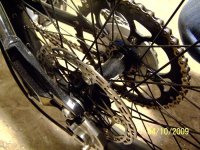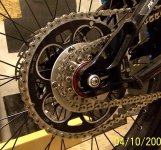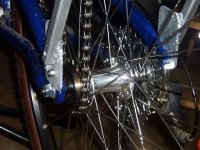northernmike
10 kW
Guys, I see a lot of you working on how to combine pedal and motor power and see it finally coming together with a few questions about Matt's drive in the last few days in other posts.
Here's my thinking - not new at all, but incomplete - I hope it contributes something.
If you use use a chain on the left side of the rear wheel hub for motor power transmission, you could leave the pedal driven side intact.
The dual sided or "flip flop" fixed gear hubs facilitate this nicely.

Typically, these are used with a "fixed", non freewheeling sprocket on one side, and on the other side, either a similar sprocket with a different amount of teeth (for a different "fixed" ratio) or a freewheel to allow the bike to coast.
My Motobecane moped uses a freewheel on the right side and a "fixed" 41 tooth (or more, I have a 45 and a 50 for experimentation later) sprocket on the left - the left being driven by the motor. I'll edit with a picture as soon as I have the opportunity, but suffice to say it's pretty much the exact same setup.
If you're powering a BMX with a huge amount of horsepower, a single ratio is perfect. But I hear from everyone else that being able to shift is really important. Driving both sides of the rear hub would mean you'd need a left-side derailleur to accomplish this - unless you could change the ratio somewhere further up the driveline. I think it was Miles that proposed the two-speed "retro direct" concept, which I like.
Here's my idea of an alternative.
Now on this particular moped, the 41T sprocket is driven by a 14T cog on an 8" v-belt pulley. That pulley is driven by the motor, but here's where it gets interesting.
The motor (on "V" designated models) is fitted with a continuously variable pulley, tensioned by a spring on the motor mount. Like so:
[youtube]1LCi6pVTb9g[/youtube]
This bike has it's crank arms removed and there are footpegs installed where they should be. But the pedal crank shaft (bottom bracket) supports the driven pulley (left side) as well as the sprocket for the pedal chain (right side).
You can see the pedal chain sprocket sitting there in the video without a chain on it. This shaft turns when you pedal - the driven pulley is on a roller bearing on the other side and so can spin independently.
The variable pulley incorporates a clutch as well so there is no resistance when pedaling.
Could this be done with an electric motor instead of gas? I don't see why not!
A crank with space on the left side for a driven pulley+sprocket would have to be engineered, that's the only "hard" part. These variable pulleys are widely available as aftermarket performance parts for many different bikes, not just Motobecane.
Worth a think?
Here's my thinking - not new at all, but incomplete - I hope it contributes something.
If you use use a chain on the left side of the rear wheel hub for motor power transmission, you could leave the pedal driven side intact.
The dual sided or "flip flop" fixed gear hubs facilitate this nicely.

Typically, these are used with a "fixed", non freewheeling sprocket on one side, and on the other side, either a similar sprocket with a different amount of teeth (for a different "fixed" ratio) or a freewheel to allow the bike to coast.
My Motobecane moped uses a freewheel on the right side and a "fixed" 41 tooth (or more, I have a 45 and a 50 for experimentation later) sprocket on the left - the left being driven by the motor. I'll edit with a picture as soon as I have the opportunity, but suffice to say it's pretty much the exact same setup.
If you're powering a BMX with a huge amount of horsepower, a single ratio is perfect. But I hear from everyone else that being able to shift is really important. Driving both sides of the rear hub would mean you'd need a left-side derailleur to accomplish this - unless you could change the ratio somewhere further up the driveline. I think it was Miles that proposed the two-speed "retro direct" concept, which I like.
Here's my idea of an alternative.
Now on this particular moped, the 41T sprocket is driven by a 14T cog on an 8" v-belt pulley. That pulley is driven by the motor, but here's where it gets interesting.
The motor (on "V" designated models) is fitted with a continuously variable pulley, tensioned by a spring on the motor mount. Like so:
[youtube]1LCi6pVTb9g[/youtube]
This bike has it's crank arms removed and there are footpegs installed where they should be. But the pedal crank shaft (bottom bracket) supports the driven pulley (left side) as well as the sprocket for the pedal chain (right side).
You can see the pedal chain sprocket sitting there in the video without a chain on it. This shaft turns when you pedal - the driven pulley is on a roller bearing on the other side and so can spin independently.
The variable pulley incorporates a clutch as well so there is no resistance when pedaling.
Could this be done with an electric motor instead of gas? I don't see why not!
A crank with space on the left side for a driven pulley+sprocket would have to be engineered, that's the only "hard" part. These variable pulleys are widely available as aftermarket performance parts for many different bikes, not just Motobecane.
Worth a think?












